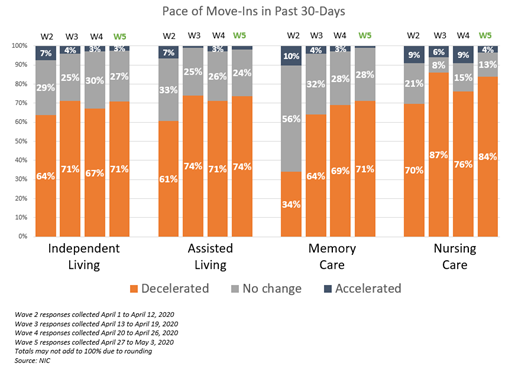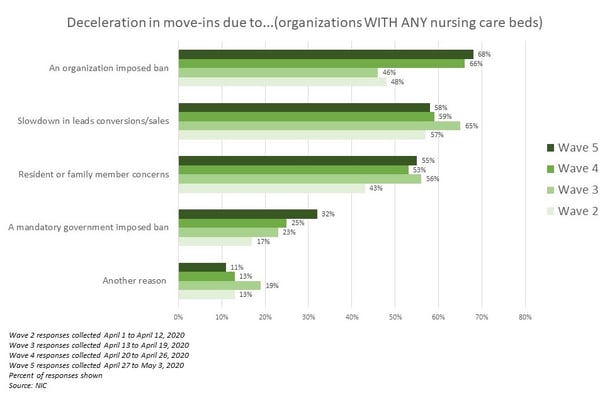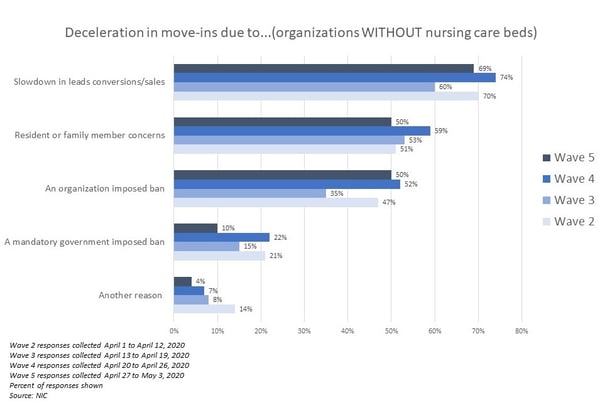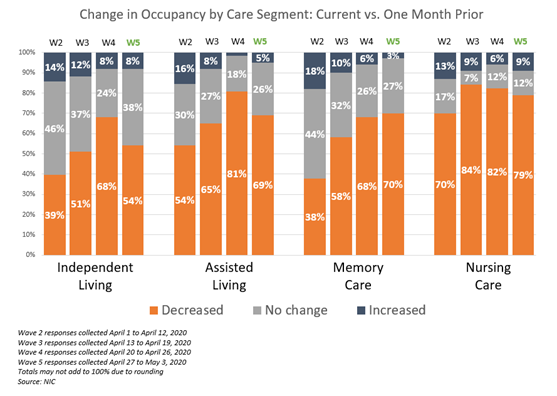A NIC report developed to provide timely insights from owners and C-suite operators on the pulse of seniors housing and skilled nursing sectors.
NIC’s weekly Executive Survey of operators in seniors housing and skilled nursing is designed to deliver transparency into market fundamentals in the seniors housing and care space at a time where market conditions are rapidly changing—providing both capital providers and capital seekers with data as to how COVID-19 is impacting the space, helping leaders make informed decisions.
This week’s sample (Wave 5) includes responses collected April 27-May 3, 2020 from owners and executives of 118 seniors housing and skilled nursing operators from across the nation. Detailed reports for each “wave” of the survey can be found on the NIC COVID-19 Resource Center webpage under Executive Survey Insights.
Summary of Insights and Findings
The majority of organizations—across their portfolios of properties—continue to report decelerations in move-ins in Wave 5. However, while fewer organizations with independent living and assisted living units reported occupancy rate declines from a month ago in Wave 5 of the survey compared to Wave 4, downward changes in occupancy rates in the memory care segment continue to grow. For the nursing care segment, the share of occupancy declines from a month ago was slightly lower in Wave 5 than in Waves 4 and 3, although still up around 80%.
- Around 70% of organizations report that the pace of move-ins decelerated in the past 30-days for their independent living, assisted living and memory care segments in Wave 5 of the survey. Only about one-quarter indicated no change in the pace of move-ins for these care segments. While most organizations reporting on their nursing care segments in Wave 5 of the survey note a deceleration in move-ins (84%), the share is slightly higher than in Wave 4 (76%) but similar to Wave 3 (87%).
- The most common reason cited for deceleration in move-ins continues to be slowdowns in leads conversions/sales due to moratoriums of moving residents into communities to mitigate COVID-19 contagion among residents and the staff members who care for them. However, more respondents in Waves 5 and 4 of the survey cited an organization-imposed ban on settling new residents into their communities than in Waves 3 and 2 of the survey.
- More organizations with any nursing care beds responding to Wave 5 and Wave 4 of the survey report an organization-imposed ban on accepting new residents than organizations without any nursing care beds. Additionally, a smaller but growing percentage of organizations with any nursing care beds, also cite a mandatory government-imposed ban on admitting new residents (17% in Wave 2 up to 32% in Wave 5).
- The majority of respondents continue to report no change in the pace of move-outs in the past 30-days in Wave 5 of the survey. The pace of move-outs reported for the nursing care segment has been consistent since Wave 2 of the survey with around one-third of organizations noting an acceleration in move-outs. However, the assisted living and memory care segments continue to see an increasing share of acceleration in move-outs.
- Among the primary reasons given for acceleration in move-outs is resident mortality. Secondary reasons cited by respondents were resident or family member concerns, residents moving to higher levels of care, hospitalizations, and planned discharges.
- In Wave 5 of the survey, approximately one-half to more than two-thirds of organizations reporting on their independent living, assisted living and memory care segments experienced a decrease in occupancy from the prior month. However, more organizations with independent living units in Wave 5 than the prior two waves saw no change in their occupancy. Organizations with memory care units report more downward changes in occupancy than in the prior three waves of the survey. The proportion of organizations reporting nursing care segment occupancy declines in Wave 5 was down slightly from Wave 3 to Wave 5.
- Roughly two-thirds to one-half of organizations with independent living, assisted living and memory care segment units noted no change in occupancy rates from one week ago in Wave 5 of the survey. However, fewer organizations with assisted living units reported occupancy declines from a week ago compared to Waves 4 and 3. About two-thirds of the organizations reporting on their nursing care segments in Wave 5 note declines from one week ago, slightly higher compared to Wave 4 and Wave 2 of the survey, but consistent with Wave 3.
Wave 5 Survey Demographics
- Responses were collected April 27-May 3, 2020 from owners and executives of 118 seniors housing and skilled nursing operators from across the nation.
- Nearly two-thirds of respondents were exclusively for-profit providers (62%), about one-third (32%) were exclusively nonprofit providers, and 6% operate both for-profit and nonprofit seniors housing and care organizations.
- Owner/operators with 1 to 10 properties comprise 55% of the sample. Operators with 11 to 25 properties make up 23% while operators with 26 properties or more make up 21% of the sample.
- Many respondents in the sample report operating combinations of property types. Across their entire portfolios of properties, 79% of the organizations operate seniors housing properties (IL, AL, MC), 35% operate nursing care properties, and 30% operate CCRCs (aka Life Plan Communities).
Key Survey Results
Pace of Move-Ins and Move-Outs
Respondents were asked: “Considering my organization’s entire portfolio of properties, overall, the pace of move-ins and move-outs by care segment in the past 30-days has…”
- In Wave 5 of the survey, between 71% and 74% of organizations reporting on their independent living, assisted living and memory care segments indicated that the pace of move-ins decelerated. However, between 24% and 28% report no change in the pace of move-ins for these care segments.
- Most of the organizations reporting on their nursing care segments in Wave 5 of the survey note a deceleration in move-ins (84%); the share is higher compared to Wave 4 (76%) and slightly lower than Wave 3 (87%).

Reasons for Deceleration in Move-Ins
Respondents were asked: “The deceleration in move-ins is due to…”
- In Wave 5 of the survey, roughly two-thirds of respondents attributed the deceleration in move-ins to a slowdown in leads conversions/sales. More respondents in Waves 5 and 4 cited an organization-imposed ban on settling new residents into their communities compared to Waves 3 and 2 (59% and 61% vs. 41% and 49%, respectively). Around one-half of organizations across each of the four data collection periods cited resident or family member concerns.
- The following charts break out the reasons for deceleration in move-ins by organizations with any nursing care beds and organizations without any nursing care beds.


- In Waves 5 and 4 of the survey, more organizations responding with any nursing care beds reported an organization-imposed ban on accepting new residents compared to organizations without any nursing care beds. In both subsamples, the percentages have grown since Waves 2 and 3 of the survey, albeit at notably higher rates for organizations with any nursing care beds.
- A growing percentage of organizations with any nursing care beds also cite a mandatory government-imposed ban on admitting new residents (17% in Wave 2 up to 32% in Wave 5).
Move-Outs
- Between 60% and 71% of organizations reporting on their independent living, assisted living and memory care units saw no change in move-outs in the past 30-days, down slightly from Wave 4 (64% to 76%).
- The assisted living and memory care segments continue to see increasing shares of an acceleration in move-outs across the four waves of the survey shown—from 13% in Wave 2 to 28% in Wave 5 for assisted living and from 8% in Wave 2 to 25% in Wave 5 for memory care.
- The pace of move-outs reported for the nursing care segment has been consistent across waves of the survey with around one-third of organizations with nursing care beds noting an acceleration in move-outs.

Change in Occupancy by Care Segment
Respondents were asked: “Considering the entire portfolio of properties, overall, my organization’s occupancy rates by care segment are… (Most Recent Occupancy, Occupancy One Month Ago, Occupancy One Week Ago, Percent 0-100)”
- Approximately one-half to more than two-thirds (54% to 70%) of organizations reporting on their independent living, assisted living and memory care units in Wave 5 of the survey—across their respective portfolios of properties—experienced a decrease in occupancy from the prior month.
- More organizations with independent living units in Wave 5 of the survey than in Wave 4 note no change in their occupancy rates compared to one month prior.
- Despite more organizations with assisted living units reporting an acceleration in move-outs over the past 30-days in Wave 5 of the survey, the assisted living segment had fewer organizations reporting downward changes in occupancy rates than in Wave 4.
- In Wave 5 of the survey, organizations with memory care units report a higher share of occupancy rates trending downward (70%) than in the prior three waves of the survey. The percent of organizations reporting nursing care segment occupancy declines in Wave 5 was down slightly from 84% in Wave 3 to 79% in Wave 5.

- Regarding the change in occupancy from one week ago, roughly two-thirds to one-half of organizations with independent living, assisted living and memory care segment units noted no change (between 63% and 55%); however, fewer organizations with assisted living units reported occupancy declines from one week ago compared to waves 4 and 3 of the survey.
- About two-thirds of the organizations reporting on their nursing care segments in Wave 5 of the survey note occupancy rate declines from one week prior (67%), slightly higher than Waves 4 and 2 (62%), but consistent with Wave 3 (67%).

This weekly survey is designed for operators to capture high level metrics with minimal time lag to market on important trends for operators and investors. While survey questions will evolve over time, primary key metrics will continue to include changes in occupancy, move-ins, and move-outs as well as COVID-19 related data.
NIC wishes to thank survey respondents for their valuable input and continuing support for this effort to bring clarity and transparency into market fundamentals in the seniors housing and care space at a time where trends are rapidly changing. Your support helps provide both capital providers and capital seekers with data as to how COVID-19 is impacting the space, helping leaders make informed decisions.
If you are an owner or C-suite executive of seniors housing and care properties and have not received an email invitation but would like to participate in the current Executive Survey, please click here for the current online questionnaire.
About Lana Peck
Lana Peck, former senior principal at the National Investment Center for Seniors Housing & Care (NIC), is a seniors housing market intelligence research professional with expertise in voice of customer analytics, product pricing and development, market segmentation, and market feasibility studies including demand analyses of greenfield developments, expansions, repositionings, and acquisition projects across the nation. Prior to joining NIC, Lana worked as director of research responsible for designing and executing seniors housing research for both for-profit and nonprofit communities, systems and national senior living trade organizations. Lana’s prior experience also includes more than a decade as senior market research analyst with one of the largest senior living owner-operators in the country. She holds a Master of Science, Business Management, a Master of Family and Consumer Sciences, Gerontology, and a professional certificate in Real Estate Finance and Development from Massachusetts Institute of Technology (MIT).
Connect with Lana Peck
Read More by Lana Peck